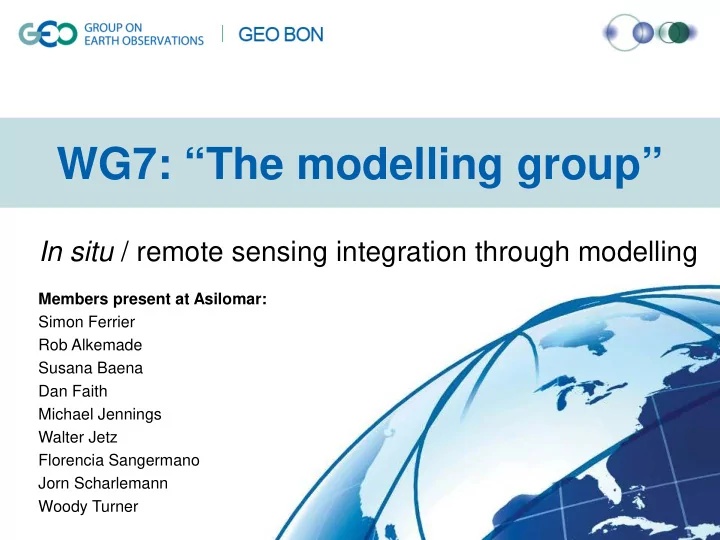

WG7: “The modelling group” In situ / remote sensing integration through modelling Members present at Asilomar: Simon Ferrier Rob Alkemade Susana Baena Dan Faith Michael Jennings Walter Jetz Florencia Sangermano Jorn Scharlemann Woody Turner
Prioritised 2015 deliverables Remotely-observed vegetation attributes, Deliverable 1: Estimated / modelled land cover / use habitat condition Global estimation of change (time series) Habitat-condition in retention of terrestrial training data, biodiversity as a function of meta-analyses etc observed change in habitat Remotely-observed condition & climate climate Species modelling (time series) (integrative occurrence Deliverable 2: Remotely-derived base predictions) for selected taxa Global assessment of environmental attributes change in representation of Modelled compositional terrestrial biodiversity within turnover for broader range of Integrated spatial taxa protected areas biological data Protected area Deliverable 3: boundaries Global projection of change (time series) in retention & protection of terrestrial biodiversity under Future scenarios of Projected habitat condition land use & climate (and climate) future scenarios of land use & climate
Links to Aichi Targets Deliverable 1: Aichi Target 5 “by 2020, the rate of loss of all natural habitats, Global estimation of change including forests, is at least halved and where feasible brought close to in retention of terrestrial zero, and degradation and fragmentation is significantly reduced” biodiversity as a function of Aichi Target 11 “by 2020, at least 17 per cent of terrestrial … areas, observed change in habitat condition & climate especially areas of particular importance for biodiversity … are conserved through … ecologically representative … systems of protected areas and other effective area-based conservation measures” Deliverable 2: + 6 th World Parks Congress (November 2014) Global assessment of change in representation of Aichi Target 12 “by 2020 the extinction of known threatened species terrestrial biodiversity within has been prevented and their conservation status, particularly of those protected areas most in decline, has been improved and sustained” Aichi Target 15 “by 2020 By 2020, ecosystem resilience and the Deliverable 3: contribution of biodiversity to carbon stocks has been enhanced, through Global projection of change conservation and restoration, including restoration of at least 15 per cent in retention & protection of of degraded ecosystems, thereby contributing to climate change terrestrial biodiversity under mitigation and adaptation” future scenarios of land use + GBO4 and IPBES? & climate
Implementing agencies & partners • Map of Life initiative (Yale University, University of Colorado etc) • Predicts initiative (UNEP-WCMC, Imperial College, UCL, University of Sussex) • GloBio initiative (PBL Netherlands Environmental Assessment Agency etc) • CSIRO • Kew Garden • Clark University • NCEAS • NASA • GBIF? • etc ...
Task leads • Environmental layer development (observed & projected) W.Jetz, F.Sangemano • Spatial biological data integration S.Ferrier, W.Jetz • Species modelling (integrative occurrence predictions) W.Jetz • Compositional-turnover modelling S.Ferrier • Habitat condition (observed change) estimation & modelling J.Scharlemann, S.Ferrier, M.Jennings • Scenarios of projected change in habitat condition & climate R.Alkemade • Modelling of change in retention of biodiversity – past-to-present & projected S.Ferrier, W.Jetz • Analysis of change in protected-area representativeness – past-to- present & projected W.Jetz, S.Ferrier • Overall coordination, synthesis, communication etc S.Ferrier, M.Jennings, S.Baena
Schedule (post-meeting plan)
Ideas for funding How much? • To achieve minimum acceptable level of rigour in results of models & analyses across the three deliverables: $3.0 million over two years • To operationalise the methodology as a dynamic online system: $?? (WG8 helping to estimate this) By whom? • Countries through CBD or GEO? • Corporations? • NSF etc?
What’s needed from other WGs & RBONs • WG1: Ongoing engagement re incorporation of genetic & phylogenetic dimensions • WG2: Potential additions to biological data for model fitting, and ongoing discussion re future model validation & calibration • WG3: Engagement needed re respective methodologies for deriving “habitat condition” and “ecosystem degradation” from remote sensing • WG4: Ongoing discussion re potential freshwater application of integrated modelling approach • WG8: Emerging collaboration to work with all WGs to develop a “whole of GEO BON” vision for interoperability, modelling & analysis • WG9: Addressing the link between our deliverables and Aichi target indicators • RBONs: Ongoing engagement re gap-filling biological data coverage through incorporation of regional datasets
Challenges and gaps • Finding the necessary funding ...
Actions and next steps • Writing “prospectus” proposal for potential funders by the end of January ...
Thank you
Recommend
More recommend